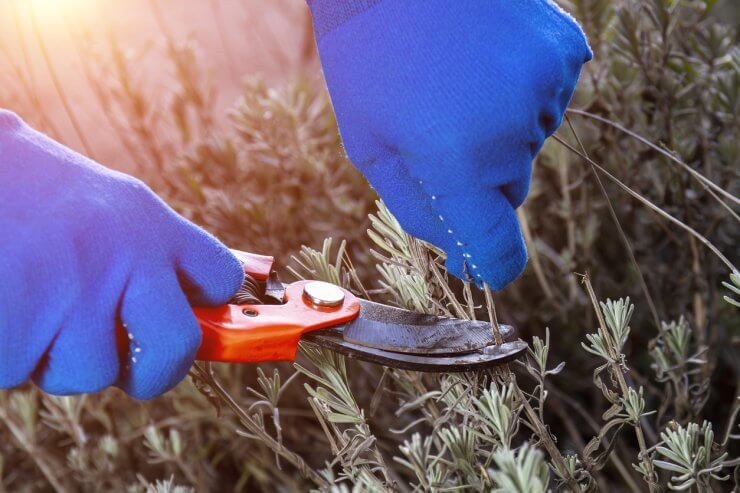
Gardener pruning a lavender plant
It’s important to prune your lavender so that it can maintain (or grow into) a pleasing, mounded shape. Plants will be modestly shaped in their first year. But by their third year, they’ll be big and bushy—if you prune them properly.
Year 1: It’s best not to expect a harvest with your first year plant. You want to encourage vigorous root growth so the plant can thrive. If you get a first year plant and it flowers, cut the flowers off and trim any new growth. This will stimulate more new growth. Some lavenders flower twice in a season. If yours does, trim it back again so the plant can focus its energy on developing a strong root system. Lavender is a fast-growing plant. It’s possible that your plant could double in size from the time you plant it in the spring to its last flowering in the summer.
Year 2: In the spring, your lavender will come out of dormancy and start growing again. This is the time to trim back all the new growth. Don’t be shy about it; give the plant a good, tight trim. This will encourage even more vigorous growth and will encourage the formation of more flowers. Be sure to harvest all your flowers before fall. After the flower harvest, give the plant another shaping. It should look roughly like a ball.
Year 3: This is when your lavender is considered fully grown, but it will keep growing for another couple of years before it reaches its maximum size. By this point, you should only need to prune your plant after the last flower harvest. If you live in an area where your lavender is lively and blooming year-round, you should cut it back when the winter months come so the plant can conserve its energy for the spring and summer blooming seasons.
Preparing for Winter
At the end of the flowering season, before winter arrives, it’s time to give your lavender plants a shaping pruning. Trim the plant to about 2 inches above the woody part of the plant, shaping it into a gentle mound. If you don’t shape it before winter sets in, come spring, it will start to sprawl out and look straggly.
Lavender is an evergreen and cold hardy, but it can still use a little TLC. Your main concern for the winter months is to make sure the crown of the plant doesn’t get overly wet. A mulch of pea gravel will help with drainage. If your winters are windy and cold, consider covering the plant with a breathable fabric cover, such as burlap or a gardening blanket. This will protect your plant from severe wind and freezing temperatures.


 Previous
Previous

